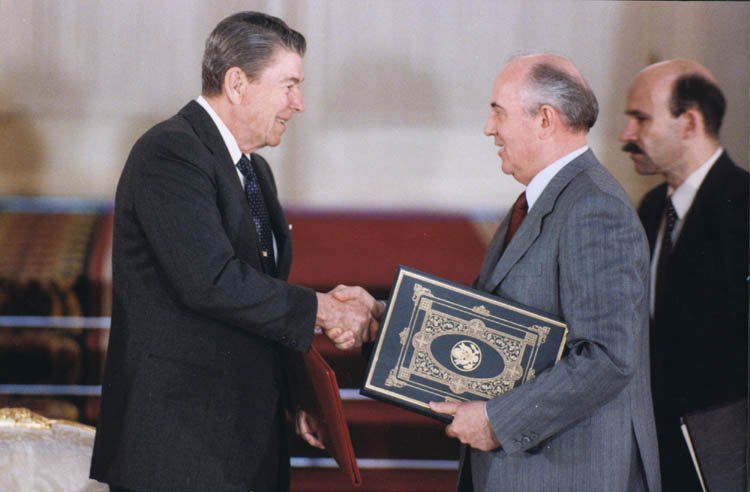This February we witnessed the true deterioration of arms control. The United States declared its withdrawal from the INF Treaty (Intermediate-Range Nuclear Forces Treaty) due to Russia’s alleged systematic violations of it. Moscow has denied any violations while casting Washington as the one reputed to breach international treaties.
The result of the breakdown is that the INF Treaty, which was signed by Reagan and Gorbachev in 1988 at the end of the Cold War, is now being terminated. Besides the expected wave of arms races in Europe, other consequences may be the ruining of the New START Treaty between Russia and the United States, which would lead to a complete vacuum in the sphere of arms control, a situation unprecedented since the SALT Treaty of the 1970s. The first affects of the current deterioration will certainly be in Europe, where the INF Treaty has served to contain escalations.
During the USSR, Ukraine possessed missile capabilities and later became a member of the INF Treaty that limited those capabilities. One outcome of the current situation is that pressures on Ukraine from both Russia and the West (NATO) will assuredly increase.
A Touch of Historic Context
The U.S. 1980s “dual track decision” that sought to both engage in negotiations while seeking to place intermediate range missiles in the field (on the territories of European NATO members as well as in European republics of the Soviet Union such as Ukraine and Belarus), was one of the first steps that led to U.S.-Russian INF dialogue. The “dual track” approach was a coercive tool used on Moscow to support negotiations over the destruction of a whole class of land-based missiles with a range from 500 to 5,000 km.
In that era, the deployment of U.S. missiles in Europe was accompanied by massive public protests. How will Europeans react now to having potential new U.S. missiles on their land in the near future? Considering that European states would be a target of Russian escalations and missiles, there will be an increase in European security concerns, and therefore it is likely that there will be public protests as well.
The Essence of the Contradiction
Over the last five years, the United States regularly blamed Russia for breaching the INF Treaty. In particular, in 2017, Russia deployed the SSC-8 (9М729) missile, which, according to Washington, went against the conditions of the INF (to not possess or deploy ground-based missiles in the 500 to 5,000 km range).
Moscow did not admit to breaching the treaty and levied its own accusations on the United States. In particular, Russia said that the European Missile Defense SM-3 launchers (already deployed in Romania and expected in Poland by 2020) had the potential to launch U.S. cruise missiles (Tomahawks). Russia also said that some U.S. drones (and training decoys) appear to violate the range limits of the INF. The United States denied the Russian arguments and went about persuading its allies that Russia breached the Treaty.
According to the U.S. ultimatums, the only chance for the Kremlin to save the INF was to remove the SSC-8 from deployment and destroy it completely. For its part, Moscow made efforts recently to prove that it had never been tested over the distance forbidden by the INF. But Washington did not believe the evidence (or had its own) and it henceforth declared its withdrawal from the Treaty (within 6-months).
The Reaction of European States
In general, the positions of European states on the issue can be divided into two groups: critics and supporters of the United States.
Among the critics are the two most prominent European states: Germany and France. Responding to the U.S. withdrawal from the INF, German Minister of Foreign Affairs Heiko Maas indicated that in spite of the obvious Russian violations of the Treaty, the U.S. withdrawal was a mistake as “Germany has no appetite for an arms race in Europe.” Some ideas have been presented as a way to find immediate solutions, such as when two Bundestag MPs suggested that Washington provide Russian inspectors access to SM-3 interceptors while Russia withdraws the SSC-8 missiles to the eastern part of Russia (where they won’t be able to target Europe).
French president Emmanuel Macron defined the INF Treaty as the essential component of strategic stability. Looking back, in the 1990s, Paris had removed its land-based missiles, probably inspired at that time by the forward-thinking example being set by Moscow and Washington. It is not clear how the French will further respond.
Estonia is an example of a U.S. supporter (although it tries to keep some balance). Estonian Foreign Minister Sven Mikser said, “While strategic weapons systems mutually threaten the United States and Russia, intermediate range and short-range missiles from Russia reach no further than Alaska on the American soil; however, virtually all targets in Europe remain within the range. Therefore, Europe’s concern over the possibility of arms control crumbling away is understandable.”
Other U.S. supporters in Europe talk about how only hard power can coerce Russia to return to the INF Treaty. UK Defense Minister Gavin Williamson has pointed out that Russia has mocked the INF for a long time, an idea supported by Poland and Latvia that have expressed their understanding of the U.S. position
NATO representatives have said the alliance condemns the Russian violations and that Russia should destroy the SSC-8. Secretary General of NATO Yens Stoltenberg, nonetheless, has declared that NATO does not want to aggravate an arms race in Europe and hopes that Russia will return to discussions during the 6-month withdrawal period.
NATO, Brussels, and individual European states are currently experiencing contradictory positions about the best way to proceed.
The Reaction of Ukraine
Ukraine is already under geopolitical pressure and more will be added now that there are issues witth the INF Treaty—taking into consideration that Ukraine was added to the Treaty’s membership in 1999 along with other post-Soviet states such as Kazakhstan and Belarus. Many believe that the annexation of Crimea by Russia happened because of Russia’s irrational fear about NATO missiles (being able to target nearby Sebastopol and other Russian cities including Moscow). The February 7, 2019, decision by the Ukrainian parliament (334 deputies out of 385) to confirm Ukraine’s path toward the EU and NATO will probably aggravate Moscow’s fears. One analysis is that Kyiv took this step as a preemptive measure in expectation of heightened Russian pressures, the end game of which may be to have Ukraine be at least neutral, seeing as it cannot become a Russian ally anytime soon.
In early February, Ukrainian Foreign Minister Pavlo Klimkin said that Russia has been violating the treaty and stated, “Ukraine will need to respond to new challenges. And we must respond to them with dignity, because we have experience, we have the necessary intelligence, we have the need to protect our country. We already have certain potential in the field of missile weapons, and it is we who will decide which missiles we need for the future.”
Some experts have already commented that it would not be too complicated to increase the range (above 500 km) of the “Neptun” and “Sapsan” missiles that are currently produced in Ukraine. If pressure on Ukraine increases, Kyiv may theoretically explore this option. However, it is doubtful that Ukraine will enhance its missile capabilities considering the export-oriented nature of the Ukrainian military-industrial complex and that the proliferation of such weapons is already a concern. However, if Ukraine dares to step over this threshold, the ensuing arms race in Europe/Eurasia—considering the potential high demand for new missiles—may critically damage the general security situation in the region.











